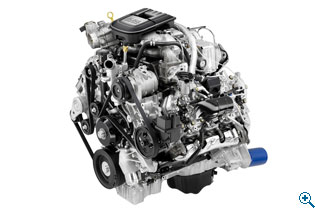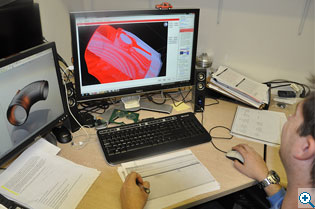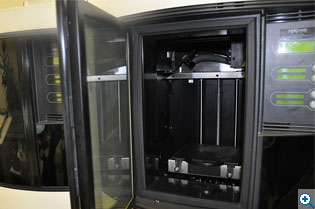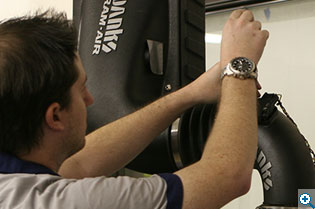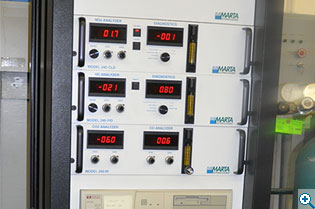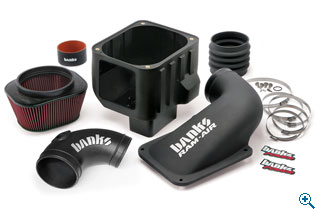LML Duramax – Could It Ever Be Better
The new 6.6L Duramax LML is the cleanest and most powerful Duramax engine to date. The question is, what will it take to develop new performance parts for the LML and similar ultra-clean diesels, and what kinds of parts will be available soon?
By John Stewart
The new 6.6L Duramax LML is the cleanest and most powerful Duramax engine to date, loaded with state-of-the-art engineering. Based on a theoretically ideal 90-degree “V” configuration, it combines a cast iron block with aluminum cylinder heads, operating at a 16.8-to-1 compression ratio. There are 4 valves per cylinder, and a variable geometry turbocharger with an air-to-air intercooler. A Bosch high-pressure common rail system enables injection pressures as high as 30,000 psi, allowing for very fine, precise fuel atomization through piezo-actuated injectors. It’s rated to produce 397 hp @ 3,000 RPM and 765 lb-ft @ 1,600 RPM.
The engine exceeds the newest, most stringent federal and California state emissions requirements by use of diesel exhaust fluid, which is injected to reduce nitrogen oxide emission levels by over 60 percent compared to prior-year LMM engines.
The engine is housed in the 2011 Silverado, a pickup that has compared favorably to the competition in recent media road tests and performance events, confirming that the engine and powertrain is already very well designed for the purpose of heavy duty work. The question is, can the Duramax be improved, and can it be improved without affecting the ultra-low emissions performance of the vehicle, in the short or long run?
It’s a difficult proposition, but the aftermarket industry is working on it, looking for opportunities based on air flow improvement and taking advantage of the ability to control nearly every system by computer. That’s not to say it will be simple. Electronic tuner specialists have leaked word that the LML controller is so different from the LMM that it will likely be many months before a selectable electronic tuning device will hit the market.
That still leaves possibilities for getting more air, and cooler air, in and out of the engine. At Gale Banks Engineering, upgrades are already in progress for the LML. One area of opportunity is the air intake system. Air density can be improved by use of an intake that improves airflow by means of a wider pathway and less restrictive filter. By taking air from outside the hot underhood area, cooler, denser air containing more oxygen can be accessed. In the end, the goal is to reduce EGT levels, or put another way, to increase power potential at any given EGT level. Pumping losses can be reduced, so the engine does not have to work so hard to breathe, creating the possibility of better mileage.
Developing An Improved Intake
Developing an improved intake is a process that starts with CAD design. To begin with, the part has to fit perfectly in the engine compartment. Once exact dimensions are confirmed, then computer simulations are used to compare different performance design ideas to the existing air filter system. The CAD designer focuses on how the shape and volume of the intake affects air flow, taking into account the available space, MAF (mass air flow) sensor placement and the need to retain effective filter capacity. Eventually, a promising design emerges and a prototype is made.
That process, once a matter of shaping a part from metal, wood or other materials by hand, is now much simpler and more exact. Using Rapid Prototype Machines, essentially a 3D plastic printer, the Banks engineer can view the CAD model, hit “print” and the machine builds up a three-dimensional plastic part. If the part is very large, sometimes multiple pieces need to be joined together to make the prototype, but even if that is the case, the prototype is available soon after. The 3D printer is accurate to within 0.01 of an inch.
Once a prototype is made, it goes to the SuperFlow ISF-1020 air flow bench for testing. The assembly is mounted on the bench, atmospheric conditions are recorded, and air flow estimates are confirmed. At this stage, the output of the MAF sensor can be monitored using an oscilloscope. It’s essential to see that the sensor outputs the same frequency as stock, at any given flow level. The MAF element is sensitive to factors such as the thickness of the tube and the angle it is mounted in sensor boss.
In the past, a small variance in MAF sensor output might not have been critical, but with the LML and other clean diesel engines, it’s important to hit the number right on. Being a little off in the MAF sensor potentially touches off a chain reaction, affecting EGR controls and other critical emissions elements downstream of the intake. At Banks, we aim for 0% variance, so that the installed part will never trigger a “check engine” light and log a code that will have to be cleared later.
Real-World Testing
Once the engineer is satisfied that the new part will improve air flow without affecting any of the other components, the part can be tested on an actual LML pickup. The test vehicle goes to Banks’ chassis dyno, where the truck will be run through a cycle that confirms the predicted performance outcomes. The truck is instrumented and data is recorded, looking at factors such as vehicle load, mass air flow, EGR valve position, and many others. If necessary, emissions testing can be done at this time as well.
In years past, before the advent of DPF-equipped diesels, that might have been enough to send the part to production. But with a vehicle like the 2011 Silverado, which has sensor-driven DPF cycles, it is still necessary to continue testing to observe how the new part reacts to regeneration cycles. This “beta test” cycle involves installing the prototype parts on actual truck(s) for an extended period of time-perhaps two months, over several thousand miles. During this time the truck will be driven normally, commuting, towing and hauling, until a series of regeneration cycles have occurred. The LML Silverado, with urea injection, needs to regenerate somewhat less often than prior Silverado pickups, so it takes longer to confirm the suitability of the new part than ever. Currently, Banks has LML intake and exhaust prototypes undergoing this type of final testing. It takes time, but in the end, the knowledge that the part will perform and be compatible with EPA emissions, not to mention California regulations, is well worth the cost.
Once final testing is complete, the part can be tooled and manufacturing can begin. It goes without saying that the manufacturing process must conform to the tight tolerances established in engineering. If, for example, the thickness of the material varies during manufacture, or permits the part to deform under high vacuum conditions, those kinds of flaws will negate the engineering work and create a part that could ultimately trigger alarms in a LML-powered vehicle. It’s all part of the process that all aftermarket manufacturers will have to adopt if they choose to work with the newest clean diesel engines. There will be some aftermarket manufacturers who will choose not to invest the time or the equipment needed to do it right, but at Gale Banks Engineering, it’s already part of our process. We’ve been doing it for many years and have accumulated a large inventory of parts that improve performance without affecting emissions levels or OEM emissions equipment. So we are optimistic that, given time, there will be bona fide performance parts for clean diesel vehicles, offering enthusiasts upgraded capabilities.
Even though development of an electronic tuning device for the LML is expected to take some time, there are other types of performance enhancers that are likely to appear much more quickly. Along with the Banks Ram-Air intake and Monster Exhaust, it’s likely that a better-performing intercooler can be developed fairly quickly, further lowering EGTs and reducing pumping losses, which relate to both power and fuel economy. Another opportunity would be for an electronic brake controller that works with the LML’s variable air flow turbo and electronic transmission, like the Banks SpeedBrake, to enhance towing control.


